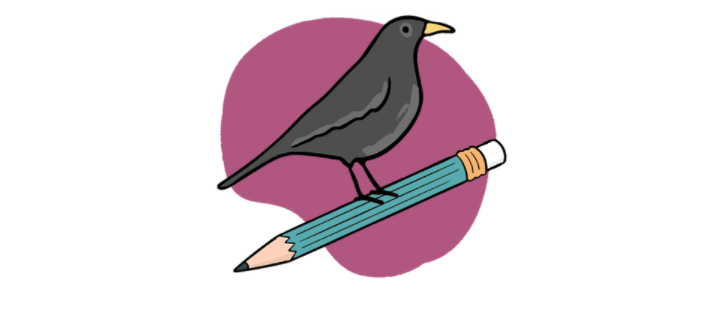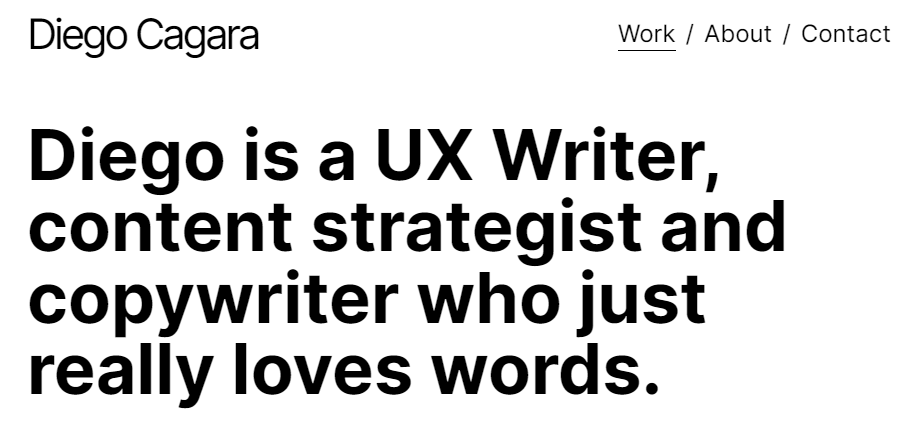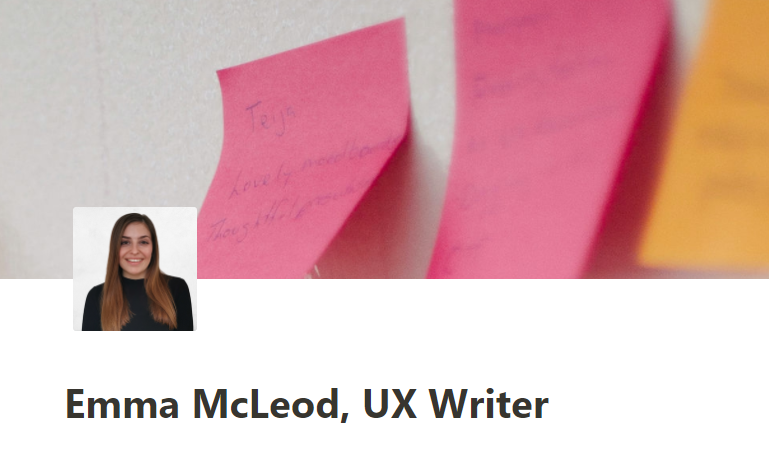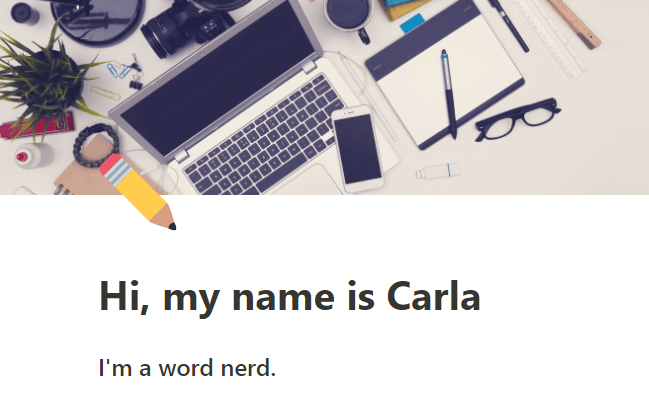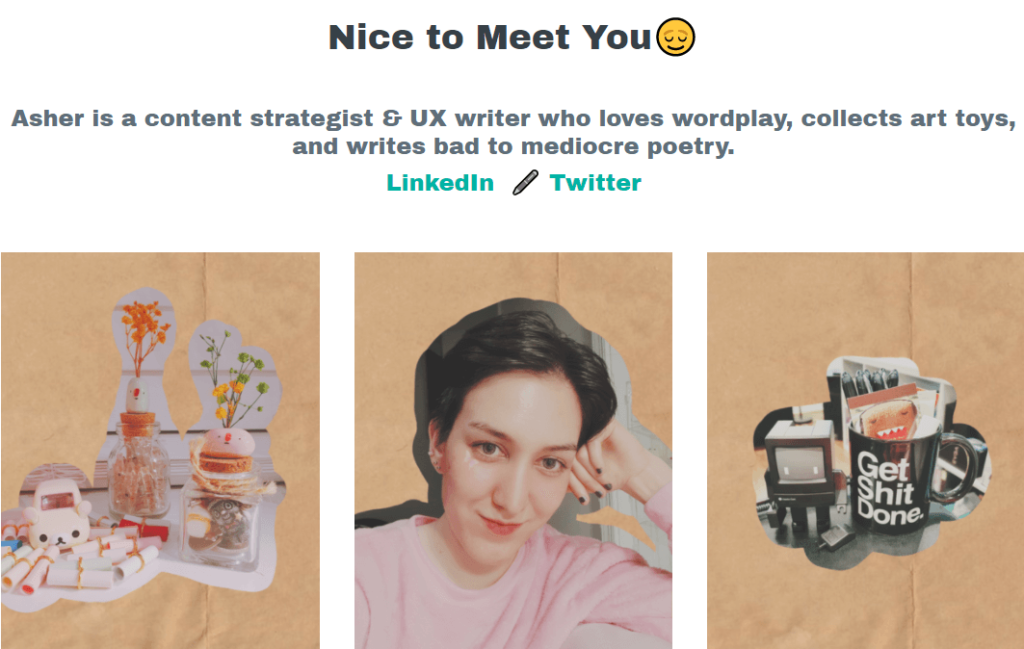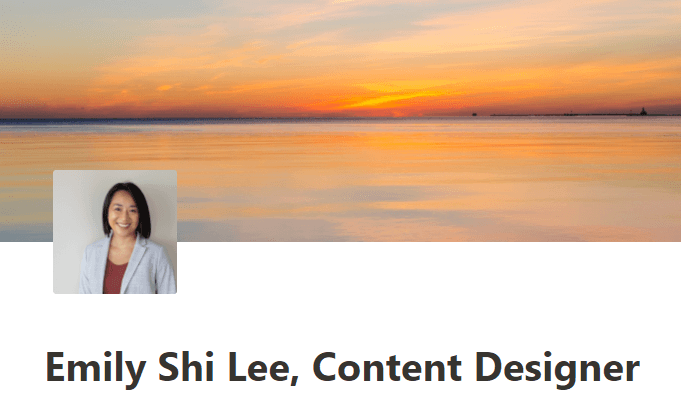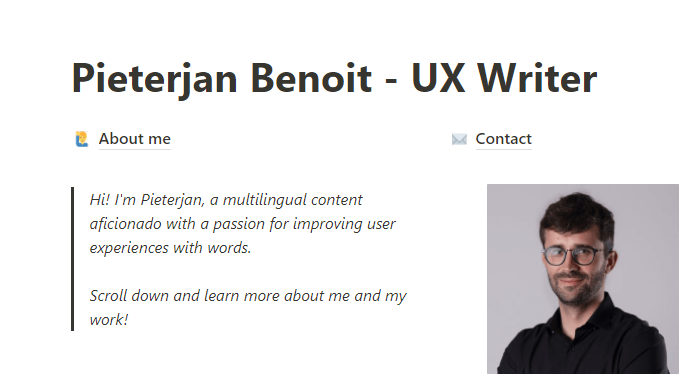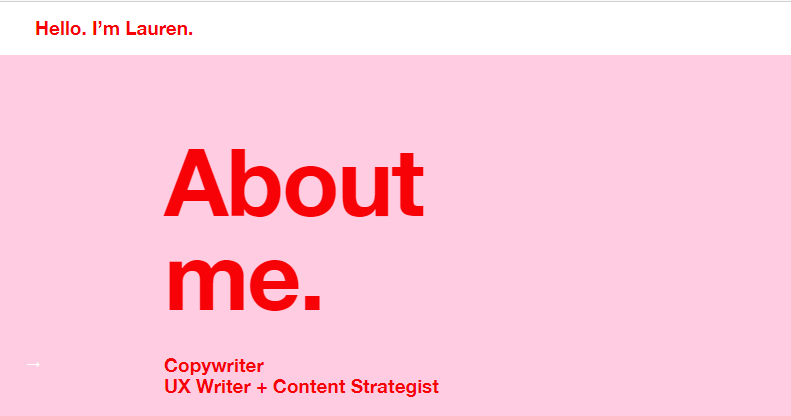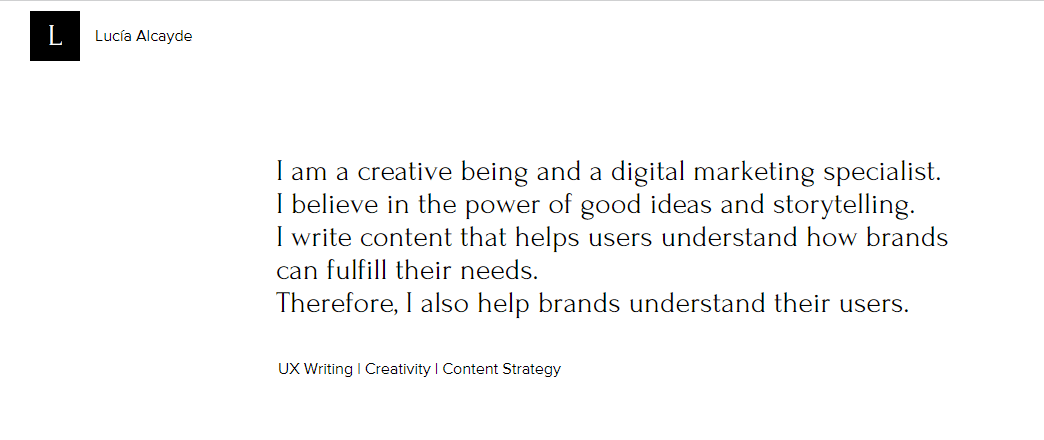Get inspired by effective portfolios by UX writing newbies. All the examples in this article are made by people who 1) have entered the industry in the last few years and 2) have landed jobs as UX writers or content designers.
Shortcuts – jump straight to:
How on earth do you make a UX portfolio without much experience?
If you’re new to UX writing and content design, you probably have a lot of questions about how to create an effective content design portfolio. While there are lots of great examples online, they often feature work from experienced content designers. Content designer portfolio examples from seasoned pros can inspire — but they can also intimidate. They are also harder to use as models because they don’t address the questions and worries people often have in their early career.
Portfolios of more senior content designers can make newbies aware of (and anxious about!) all the things they don’t have: UX job experience, “real world” samples, extensive research, outcome analytics, a fancy website. The good news is that you don’t need all of these things to land a job.
As Jan Haaland, founder of Case Study Club, says in the podcast episode From case study writing to writing robots, employers are looking for different things in entry level and senior positions. And this article by Jonathon Colman at HubSpot gets very specific about exactly what they look for. Bookmark it in case of anxiety attack – it’s a refreshing reminder that you are not expected to have it all.
4 Early-career Portfolio Challenges Solved
The portfolios in this article were chosen because they offer examples of how to address some common challenges early-career content designers face. They will show you how to make the most of what you do have, including student projects, side/personal projects, work in other fields, user testing, and even your sparkling personality.
All the portfolios featured below come from students in the UX Writing Academy. And all of these portfolios helped the writers who created them land jobs, so you know they work.
Challenge #1: Few (or no) professional samples
A common Catch-22 for people entering any field is that you often have to have experience to get experience. While experienced content designers can showcase projects they’ve done for employers, newbies have to get more creative to demonstrate their skills.
Some new content designers wonder if showing personal projects is “allowed” — and the good news is, it absolutely is. Have you sketched out improvements to an app you thought had some flaws? Done a 30-day UX writing challenge? Created a prototype of a fictional product in a class or on your own? All of that can go in your portfolio. In fact, HubSpot says they welcome side projects and volunteer projects.
All these things can demonstrate your skills and thought processes – and show you’re passionate and eager enough to try things on your own.
Sarah Kessler
Take a quick glance at Sarah Kessler’s portfolio and you might think she has years of UX writing experience. Six samples, and text at the top that says these are not all of her work. Yet many of these samples were made outside of the workplace: a UX Writing Academy project, a UX Writing daily challenge, a speculative project that was a take-home assignment from a job interview.
Sarah is open about the origin of these projects, and lets the work stand for itself. These projects reveal her thought processes, ability to create great work and communicate it, and demonstrate that she is committed to learning more and more about the field.
➡Sarah talks about becoming a UX writer from scratch in an episode of Writers in Tech⬅ – check it out!
Takeaway: Show it all. Whether or not you were paid for it, your work shows potential employers what you can do. What matters is not whether your samples were created in a professional setting but that you present them in a professional way.
Diego Cagara
Diego Cagara has several professional projects on his portfolio, and he does a nice job connecting his past experience in journalism to his UX work (including a Medium article he wrote that makes the link explicit). But he also includes a student exercise that provides a great example of how he thinks through content design challenges. “Unfriendly Skies” is a project that involved writing copy for four different use cases for an airline app. He includes the situation, his copy, and the rationale for each. In this way, he shows both his work and his thinking. And perhaps most importantly, his conclusion explains what he learned.
Takeaway: As we see over and over, the more you can demonstrate how you think – about specific decisions, and your learning process over all– the better. The next time you encounter a less-than-delightful digital experience, consider what you would do to fix it, and articulate why your fix would be an improvement.
Challenge #2: No (or minimal) research
Because these portfolios all come from UX Writing Academy students, they all include at least some research. That’s because the program emphasizes the importance of research in content design, and includes it as an important part of the final project. However, the research for those projects was all conducted a) for free and b) on original (invented) products. That means these are all things you can do on your own.
Some of these portfolios also include smaller, minimalist design projects that were not based on research. That’s fine, but if these make up the bulk of your samples, it will help to describe what research you would conduct, if you were in a different setting or had more resources. Many of the samples below include “Next Steps” sections – a list of additional research steps that the UX writer would conduct if they were able to.
Emma McLeod
There’s lots to love in Emma McLeod’s simple but effective portfolio. It consists of three samples, two of which are personal projects. Research is often a hurdle for early-career content designers.
Emma’s student project demonstrates both how much you can do on your own, and how to handle what you can’t do. She used a number of research tools for her project, including market research, surveys, user interviews, and conversation mining. However, because this is not a “real” finished product, there were some limitations, so she included an explanation of what she would do if she could.
Takeaway: You can do a lot of research with minimal resources, and explaining what you would do if you could goes a long way. If you’re working on a personal project, try mapping out an ideal research plan. Then see what on the list you might be able to accomplish with the resources you have.
Carla Kargaard
Carla Kargaad’s portfolio features another personal project that demonstrates how much research can be done with no resources. Her project included two full designs, with different voice and tone options (as well as different visual design).
In addition to showing off her ability to conceive of and write in different brand voices, this also demonstrated that she can let go of her own ideas based on the research. While creating her product, she saw that the voice could go one of two ways: edgy (her favorite), or a slightly more conservative approach. So she built and tested both, and found that the latter was more effective. While she may have had to jettison her favorite design, sharing the process may have helped her land a job.
Takeaway: Even without a live finished product, you can test the way different versions perform. If you are deciding between two choices in a personal project, try making two versions and then conducting basic user testing. You might be surprised how much you can do.
Asher Lee Sherman
Asher Lee Sherman also did a lot of research on a student project. The project, an e-commerce store for colored contact lenses, is an excellent example because it clearly demonstrates the goals of the research and precisely what was done. This makes it useful for newbies who may be wondering how to do research like this, as well as how to present it. One place this sample shines is all the conclusions drawn from the research.
Takeaway: While this particular case study is backed up with lots of research, making strong conclusions from your research is a lesson anyone can learn from. This demonstrates to employers that you are able to make the most out of your research, even if there’s not much of it.
Challenge #3: Lack of resources for a fancy website
There are a number of tools to easily and cheaply create a simple portfolio site, but the easiest of all may be Notion. You may know Notion as a productivity tool, but it can also let you create an attractive portfolio site in an afternoon (for free!). Many of the portfolios featured in this article are built in Notion. By creating a simple and effective site, you can focus more on what matters: the quality of the work in your portfolio.
Emily Shi Lee
Emily Shi Lee offers an example of how to do a lot with a little. On a single page, she introduces herself, offers a quick but thorough guide to her primary sample (click through to see her excellent case study), provides links to smaller UX writing samples, gives more information about herself, and offers a testimonial as proof of her chops. The site is easy to digest, and shows her personality and skills.
Takeaway: Start simple. There’s no need to dress up your work with bells and whistles. Visitors to your portfolio are interested in your work, and that can shine in a simple portfolio.
Pieterjan Benoit
Pieterjan Benoit’s portfolio is another example of a lean yet deep Notion-based site. You get a great sense of all Pieterjan has done – work experience, UX samples, other articles, and more – without feeling overwhelmed. The page provides a thorough and holistic sense of Pieterjan’s work and personality, while providing plenty of opportunities to learn more.
Takeaway: Using a simple tool allows you to focus less on learning a complicated product and more on expressing yourself and sharing your authentic personality.
Challenge #4: Expressing your personality in your portfolio
One advantage a portfolio has over a traditional resume is that you can express more of your personality. For new UX writers, this is a huge benefit. You may only have been honing your UX writing skills for a short time, but you’ve had your whole life to develop your personality.
While it’s possible to go overboard, judicious use of your authentic voice will give visitors a sense of who you are and what it would be like to work with you.
Since voice and tone are such a key component of UX writing, the copy on your portfolio is a great opportunity to show what you can do. You can think about your own brand voice in the same way you would approach a company’s. Are you hyper-professional or more casual? Playful or all business? The portfolios below all do a great job integrating the authentic voice of the writer.
Lauren Reichman
Looking at Lauren Reichman’s portfolio, you could be forgiven for wondering why it is included in a list of early career portfolios. She has an extensive background in content strategy and copywriting, areas that overlap enough with UX writing to provide useful projects/samples. Her case studies are definitely worth a look, even if they intimidate a little! But you’ll also find an excellent example of how to express your personality in your case studies.
Check out her 404 pages project, for example. Lauren set herself a simple challenge to create 30 404 pages for her portfolio site. These are delightful to browse and serve as a useful model of what you can create on your own. While many UX writing challenges are designed to practice lots of different things (and including them in the portfolio can demonstrate breadth), focusing on a single element allows Lauren to show her limitless creativity.
Takeaway: Do you have a favorite element to write? Or something you want to improve? Follow Lauren’s example and create 30 examples for your own portfolio site.
Lucia Alcayde
In four sentences at the top of her portfolio, Lucia Alcayde elegantly describes herself, her values, her job and skills, and her benefit to clients:
“I am a creative being and a digital marketing specialist. I believe in the power of good ideas and storytelling. I write content that helps users understand how brands can fulfill their needs. Therefore, I also help brands understand their users.”
This simple (even poetic) statement gets across Lucia’s unique approach to the field of content design, and the benefits of that approach. Her case studies reflect this, too.
Takeaway: Be yourself. The way you think about your work and your role in the world will come through in your voice when what you’re saying is authentic.
More tips for portfolio makers and job seekers
Articles
The ultimate UX portfolio resource (70 examples plus tips on how to get started)
8 tips to ace UX writing interviews
3 things that helped me get a job in UX (and 3 that didn’t)
Podcast episodes
From case study writing to writing robots (with Jan Haaland from the Case Study Club)
Believe in content design (with HubSpot’s Jonathon Colman, who explains what recruiters look for when hiring)
UX writers are designers (with tips from Hailey Reynolds on how to write a cover letter)
Becoming a UX writer from scratch (with Sarah Kessler)
Want to become a UX writer?
If you would like to get more experience, consider the UX Writing Academy. All the portfolios in this article came from Academy students (and all landed jobs), so if the caliber of the work here impressed and inspired you, you may want to join the next cohort.

